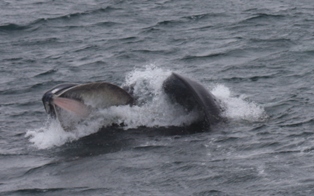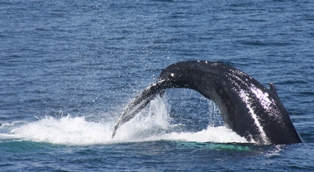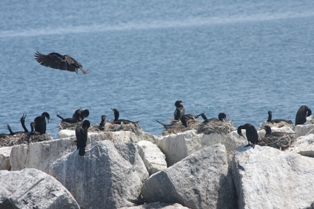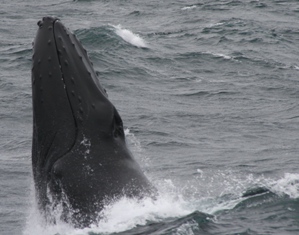Dolphin Fleet Naturalist Notebook May 29th to June 4th
We left Provincetown on May 29th with light rain and calm seas. We saw a diversity of marine life, with 17 humpbacks, 1 mink whale, 1 harbor seal and 5 gray seals! Many of the humpbacks appeared to be young, possibly juvenile whales. It is common for juvenile humpbacks to appear on the feeding grounds earlier than adult whales, especially nursing mothers who have to wait until their calves are strong enough to endure the long migration back to Stellwagen Bank. Towards the end of our trip we encountered two curious humpbacks that swam around our boat, giving us an opportunity to appreciate the true size of the animals. We also spotted a Wilson’s Storm-petrel, a small dark brown sea bird with a white rump. These birds are trans-equatorial migrants, they breed on the Antarctic coastline and spend the rest of the year at sea (North Atlantic) where they feed on planktonic prey found near the sea surface.
We sailed out to Cape Cod Bay on May 30th with ideal whale watching conditions—clear skies, low wind and glassy-calm seas. We observed 14 humpback whales, 1 finback whale and 1 harbor seal! Many of the whales were traveling linearly and going a high-fluking dives, which made for easy identification. We identified Freefall, Thread, Salt, Cardu, Reflection and calf, Anchor and calf, Palette and calf and Zeppelin and calf. Stellwagen Bank is often referred to as a nursery ground as there is a disproportionately high number of mother and baby whales on the bank. It is likely that Stellwagen Bank’s attractiveness to nursing mothers has to do with the relative abundance of prey, as mothers have high energetic requirements and therefore need to eat as much as possible without expending much energy. It is especially important that nursing mothers get enough food to eat so that they can continue nursing their young, which are dependent on their milk for survival. Female whales nurse their young with their two protractible teats that are located on either side of their genital slit. When the calf is hungry, the female’s nipples will protrude and the calf will grasp the teat between its tongue and upper jaw. The mother will then squirt approximately 120 gallons of her energy rich milk into the calf’s throat. These nursing sessions only last a few minutes, however, they occur roughly 40 times per day! During this time calves will grow quickly, doubling their length by the time they are weaned. The calf will remain associated with its mother for about a year and weaning will begin when the calf is 5 or 6 months old, however, some humpbacks continue nursing after one year. While the calf is associated with its mother it will learn how to feed, in fact, some humpback calves have been observed feeding on Stellwagen Bank such as Scylla’s 2008 calf, Hazard. Once the summer is over the calf will migrate back down to the Caribbean with its mother and eventually the pair will separate and the calf will gain its independence.
Towards the end of the day we observed various humpback feeding behaviors such as bubble feeding, kick feeding and surface lunging! It is thought that humpbacks will only engage in lunge feeding when food is abundant. The whales may approach the prey from underneath or beside and then open its mouth just before surfacing and then lunging through the prey patch. As the humpback lunges, its throat groves or ventral pleats expand, allowing the whale to maximize its food intake. Once the whale’s mouth is full, it will contract its throat groves and press its tongue against the plates of baleen, forcing out the water and trapping the fish inside its mouth.

Lunge feeding
On May 31st we sailed out to the Southwest Corner of Stellwagen Bank where we observed three different baleen species. We sighted 23 humpbacks, 3 finbacks and 2 minke whales! It appeared as though the whales had found a large school of sand lance, as the humpbacks were engaging in various feeding behaviors including kick feeding and bubble nets. Humpbacks create bubble nets by swimming in a circular motion under a school of fish and releasing bubble columns at regular intervals. Once the bubbles reach the surface, they will form a circle around the fish and make the fish concentrate into a tight ball, making it easier for the whales to trap the fish. For the humpbacks to ensure survival they must consume enough food to replenish their depleted blubber reserves. An average humpback will require a ton of fish per day, which equals a million plus calories. The finbacks also appeared to be feeding as they were circling. Circling is a common feeding behavior that is thought to coral sand lance into tight balls making it easier for the whales to catch their prey. We identified several adult humpbacks including: Scylla, Ventisca, Tongs, Jabiru and Abrasion and calf.
On June 1st we left Provincetown with perfect weather; bight skies, light wind and calm seas. Without traveling far we found 25 humpback whales that were engaging in feeding behaviors, including lunging, kick feeding and bubble feeding. Kick feeding is a site-specific behavior, it has only been observed in the Gulf of Maine. Humpbacks will lob tail at the surface sending a shockwave down to a school of fish below; this essentially stuns their prey making it easier for the whales to catch the fish. Sometimes humpbacks will release bubbles under a school of fish after a kick feed and then surface with open mouths. The bubbles may confuse the stunned prey, making them concentrate into a tighter ball to avoid predation. We identified Ventisca, Gumdrop, Stub, Filament, Putter, Tongs, Rune, Trident and Fulcrum, Fern and calf and Bolide and calf.

Kick feeding
On June 2nd we sailed past the Double-crested Cormorants that were nesting on the Provincetown harbor breakwater with grey skies and moderate seas. Double-crested Cormorants are dark-colored waterbirds that are widely distributed across North America. These birds make a living off small schooling fish, and hunt their prey by swimming and diving. Their feathers, however, are not waterproof and they must spread their wings to dry their feathers while on land. Cormorants can be seen feeding in the presence of humpback whales, as they share the same appetite for sand lance. In fact, in 1982 a dead humpback whale was found with six cormorants in its stomach. It is thought that the whale accidentally swallowed the birds while they were stealing fish from inside its mouth.
We traveled out to Race Point and found 16-24 humpback whales and 5-6 finback whales. The majority of the whales were bubble feeding (including Dome, Tongs and Thumper), while one humpback named Pisces became curious of our boat!

Double-crested Cormorants
On June 3rd we steamed out to Race Point with bright skies and moderate seas and came across a large group of 30-36 feeding humpback whales, 5 finback whales and 1 minke whale! The fish that the whales were feeding on appeared to be near the surface as the whales were mostly bubble feeding by creating bubble nets around the schools of fish. Many of the observed surface-feeding humpbacks were employing cooperative feeding strategies by forming large bubble nets around the fish and surfacing together with wide-open mouths. From the boat we were able to see the hundreds of plates of baleen hanging down from the whale’s top jaw. Whales employ different feeding strategies based on the quantity and location of prey. For instance, many of the humpbacks on Stellwagen Bank have scuffmarks on the side of their jaw from feeding on sand lance on the sea bottom. Sand lance will hide in the sandy substrate of Sellwagen Bank to avoid predation; the whales will lean to one side, open their mouths and scoop up the fish. These scuffmarks are usually only found on one side of the whales jaw.

Humpback with scuffmark on right jaw
We headed to Stellwagen Bank on June 4th with grey skies and calm seas. We observed 18 humpbacks, 6 finbacks and 1 minke whale! The whales exhibited a myriad of behaviors, including various active and feeding behaviors. In the morning the whales were breaching with chin breaches and spinning breaches! The afternoon, however, was quite different with kick feeding, open mouth feeding, bubble clouds and dragging! In order to expel the salt water, which whales cannot swallow, humpbacks will swim forward with their tongues pressed against their baleen and their chins out of the water. This dragging behavior forces out the salt water and traps the fish inside the whale’s mouth. We identified Rapier, Pogo, Fracture, Hazard, Apostrophe, Eruption, Bolide and calf and Fulcrum and calf.

Chin breach





